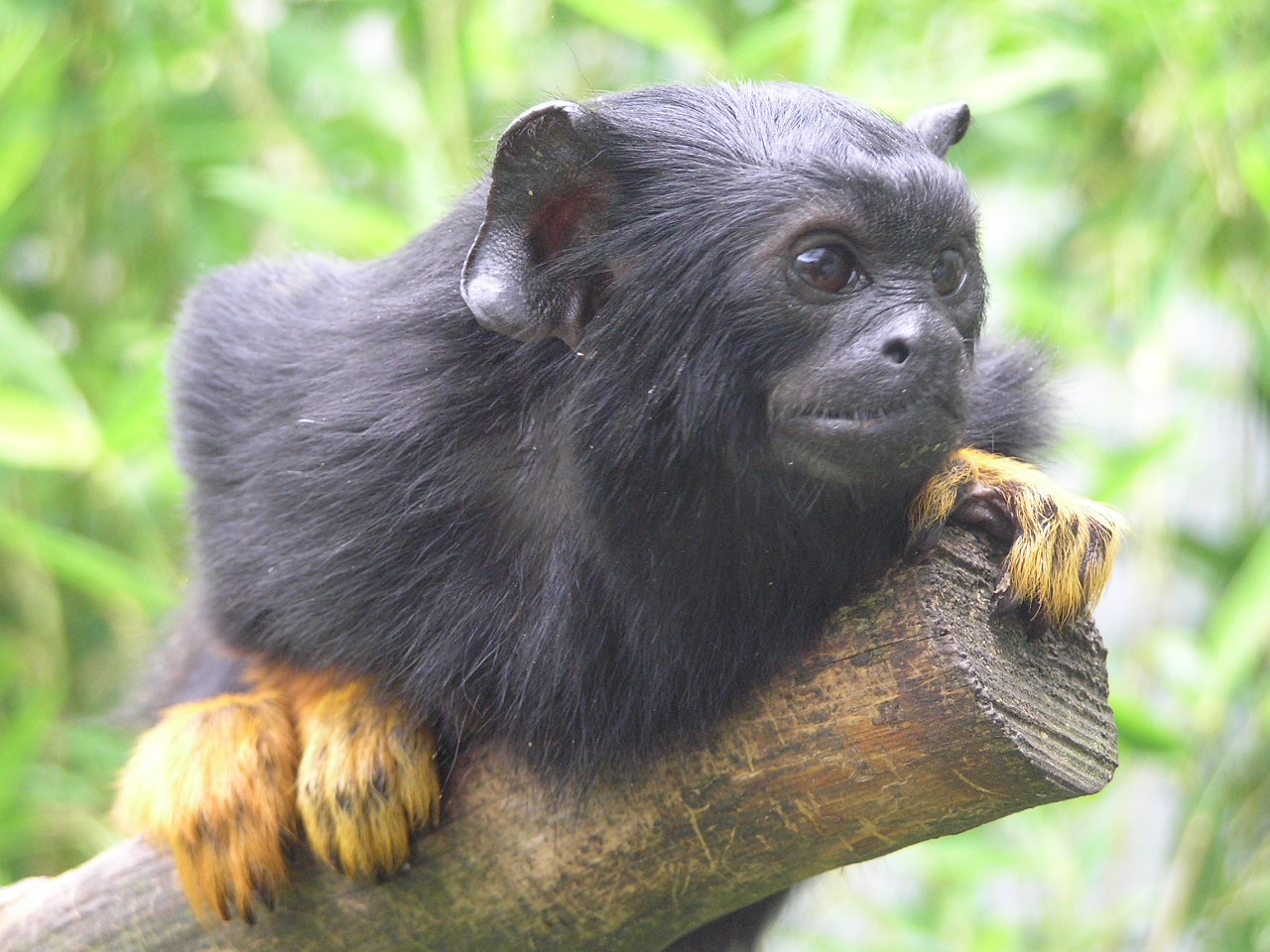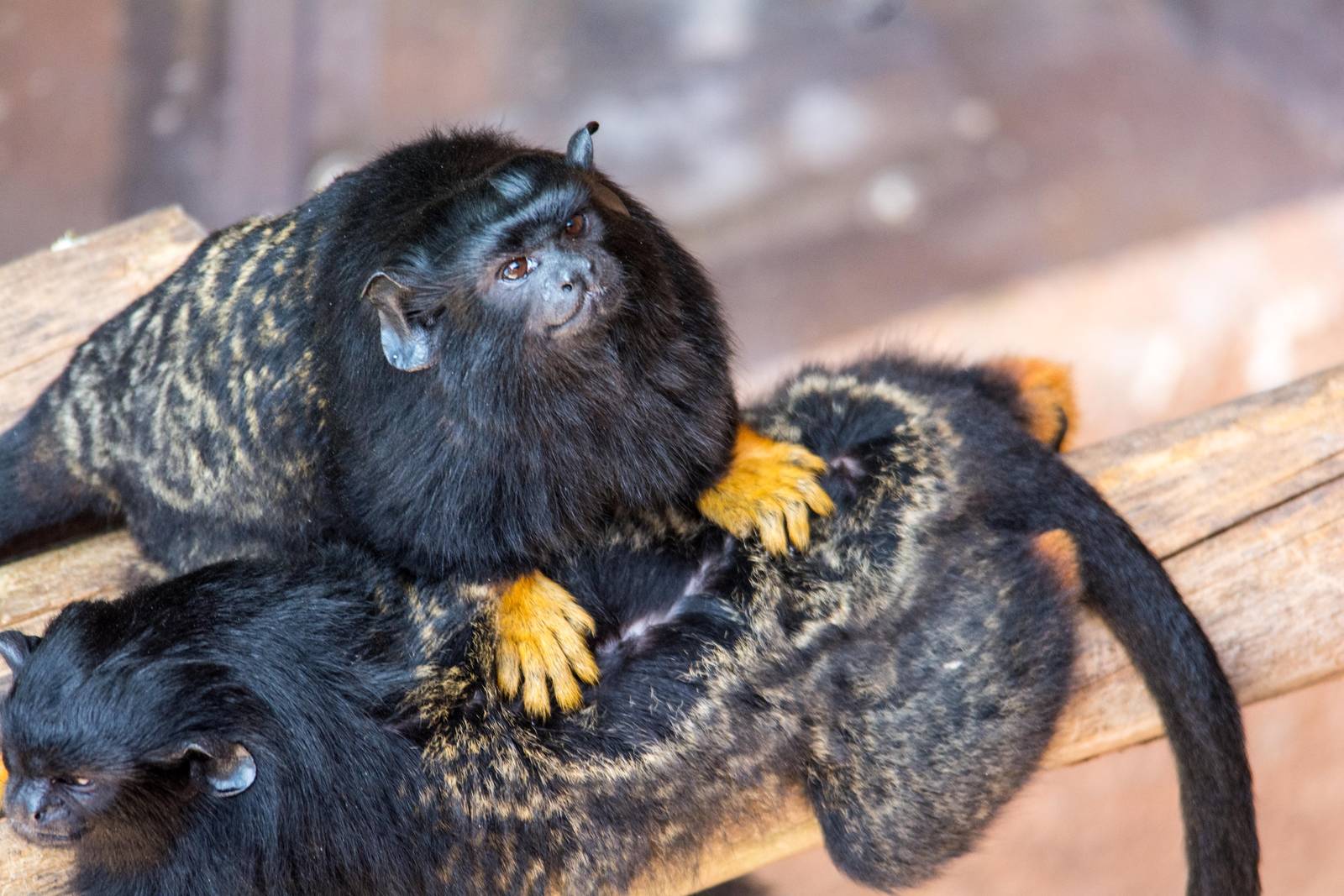Beautifully designed with an overall black body and a perfect touch of gold on its hand and back – the golden-handed tamarin monkey is a sight to behold in Guyana. They are also called the red-handed tamarin or midas tamarin, they are New World monkeys belonging to the Callitrichidae family. Amazingly, the golden-handed tamarin is an exceptional climber and spends most of its time among the vines and branches of the trees. It is quick and agile and is a superb jumper known to jump distances of over 60 feet (18 m) from a tree to the ground with no sign of injury. Yes, this monkey has some impressive skills and features that you will unquestionably admire.
Features Of The Golden-handed Tamarin

Golden-handed Tamarin | Image Source: Wikipedia
- Face – The face is dark and hairless and their big ears stick out of their fur. As with all marmosets, they have claws instead of nails on the fingers and toes (with the exception of the big toe). Furthermore, the thumb is not opposable.
- Fur – The fur of this tamarin is dark brown or black, with contrasting reddish-orange to goldish hair on its feet, hands and back (hence the common name).
- Size & Weight – The body measures 20.5–28 centimetres (8.1–11.0 inch); including the tail it measures 31–44 centimetres (12–17 inch). It weighs 400–550 grams (0.88–1.21 lbs.).
- Scent Glands – There are specialized scent glands in the midchest and around the genitalia, the secretions of which are used to mark territory and convey information about identity, status, and sexual receptivity of individuals.
Scientific Classification Of The Golden-handed Tamarin
Golden-handed Tamarin – Saguinus midas [Scientific name]
- Kingdom: Animalia
- Phylum: Chordata
- Class: Mammalia
- Order: Primates
- Suborder: Haplorhini
- Infraorder: Simiiformes
- Family: Callitrichidae
- Genus: Saguinus
- Species: S. midas
Habitat Of The Golden-handed Tamarin
The golden-handed tamarin is native to wooded areas north of the Amazon River in Brazil, Guyana, French Guiana, Suriname, and possibly Venezuela. A population of tamarins south of the Amazon River that lack the contrasting feet and hands was previously believed to be a sub-population of golden-handed tamarins but is now treated as a separate species, the black tamarin. Golden-handed tamarins prefers trees with small crowns. Often seen holding onto tree trunks in a vertical position, while it nervously peers and quickly moves its head about. It makes a high-pitched whistle that once learned is clearly recognizable. It also makes a variety of bird-like chirps when alarmed.
Tip: Defense is a priority in a group of tamarins, and when one tamarin is threatened the others will rush to its defense. The golden-handed tamarin is territorial and can be aggressive, with sharp canines and claws instead of fingernails on all fingers and toes except the large toe.
Diet Of The Golden-handed Tamarin
They are omnivores. Their diet consists of leaves, plant exudates, fruit, flowers, eggs, insects and other arthropods, frogs, spiders, lizards, and nectar. Further, their natural predators include small cats, birds of prey, and snakes.
Reproduction Of The Golden-handed Tamarin
Only one female in the group will breed during breeding season with the other females suppressing the instinct. The gestation period is 140–170 days and mothers typically give birth to two offspring. Young tamarins are cared for primarily by the father and turned over to the mother only to nurse, however the entire group helps with the care of the young. The young weigh about 45 grams at birth and weaning occurs at age 2-3 months. Adults can reach sexual maturity at age of 16-20 months. These tamarins live in cooperative groups of 4 to 15 members with little competition within group even between breeding males.
Did You Know? The life expectancy of the golden-handed tamarin is approximately 10 years in the wild and 16 years in captivity.
Behavior Of The Golden-handed Tamarin
These tamarins are active by day and hold a territory of approximately 10 hectares. Within the group, there is little intragroup aggression and much cooperation and tolerance. They are mostly arboreal, and leap from tree to tree or tree to ground, and have been known to make leaps from as high as 18m – 20m to the ground without any sign of injury.
Golden-handed Tamarin In Guyana
This species has not been recorded on the west side of the Essequibo River in the vicinity of Iwokrama. However, further south it is found west of the western tributary of the Essequibo (Illiwa or Rewa) River. It is fairly common on the east side of the Essequibo adjacent to the reserve, and with further survey work it probably will be found in Iwokrama. They can be seen along farm edges in the North Rupununi and are found in lowland, hilly forest, savannah forest and white sand forest with a preference to forest edge in trees with small crowns. Yes, Guyana is privileged to have these uniquely designed monkeys; their skills and features are definitely impressive.
Article References:
- https://animaldiversity.org/accounts/Saguinus_midas/
- https://www.factzoo.com/mammals/red-handed-tamarin-monkey-golden-touch.html
- https://iwokramariverlodge.com/portfolio/golden-handed-tamarin/
- https://www.stabroeknews.com/2012/features/03/11/golden-handed-tamarin/
- https://en.wikipedia.org/wiki/Red-handed_tamarin
- Main Image source: Golden-handed Tamarin – https://www.zoochat.com
Discover more from Things Guyana
Subscribe to get the latest posts sent to your email.







